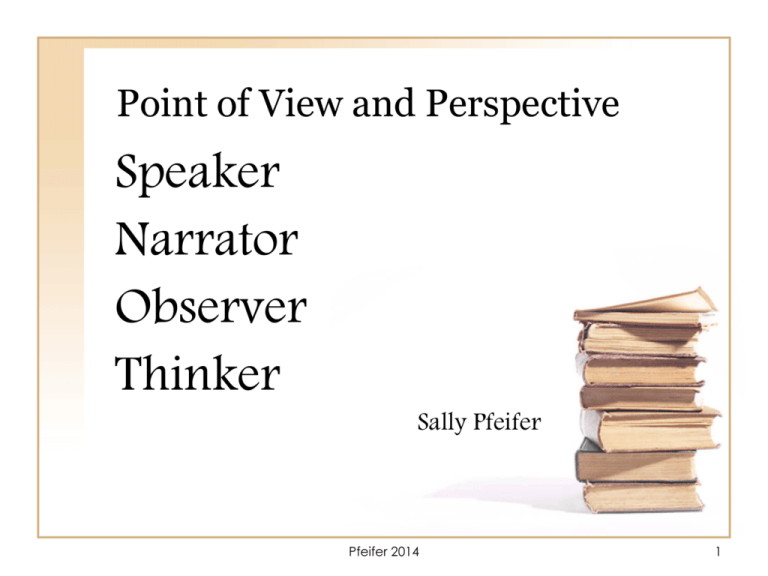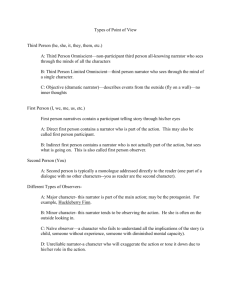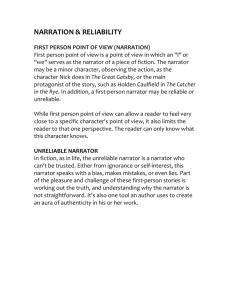first-person point of view
advertisement

Point of View and Perspective Speaker Narrator Observer Thinker Sally Pfeifer Pfeifer 2014 1 Point of View Analysis in Close Reading • The first decision a writer of prose fiction (novel/short story) will make is point of view. At this point in students’ language study they should know the difference between 1st person point of view and 3rd person point of view--but there is so much more to this important literary technique. Pfeifer 2014 2 Point of View Analysis in Close Reading • The narrator who tells the story provides the reader with one perspective about the events. • The author determines whose words are being read, where the narrator stands in relation to the events, and whether the events are viewed from a fixed or mobile position. • The choice is deliberate; a different view would change the story significantly. • POV= precise effect on the meaning of story Pfeifer 2014 3 1st Person Point Of View [Participant] • The participant point of view is also called the first-person point of view because first-person pronouns (I, me, my, we, us, our) are used to tell the story. This narrator can function in one of two ways: 1. The narrator as a major character in the story (the story is told by the narrator and is chiefly about him). 2. The narrator as a minor character (the narrator tells a story that focuses on someone other than herself, but she is still a character in the story). Pfeifer 2014 4 The stance that the author gives this character is the first decision the writer makes after deciding on 1st person point of view. The stance may be one of three: 1. Subjective: a major or minor character who reports the events as if they just happened, and who appears to be unaware of the full meaning of the events. • A special type of participant narrator is called the innocent-eye narrator. [This character is usually found in the subjective stance.] The character telling the story may be a child or a developmentally disabled individual; the narrator is thus naive. The contrast between what the innocent-eye narrator perceives and what the reader understands may produce an ironic effect. • Novel: The Adventures of Huckleberry Finn Pfeifer 2014 5 “Eleven” Sandra Cisneros Only today I wish I didn't have only eleven years rattling inside me like pennies in a tin Band-Aid box. Today I wish I was one hundred and two instead of eleven because if I was one hundred and two I'd have known what to say when Mrs. Price put the red sweater on my desk. I would've known how to tell her it wasn't mine instead of just sitting there with that look on my face and nothing coming out of my mouth. Pfeifer 2014 6 1st Person Point of View 2. Detached: a major character who recalls events from the vantage point of maturity and may reflect on the meaning of these events from his/her past. Novel: To Kill a Mockingbird Pfeifer 2014 7 “The Use of Force” William Carlos Williams Then I grasped the child's head with my left hand and tried to get the wooden tongue depressor between her teeth. She fought, with clenched teeth, desperately! But now I also had grown furious--at a child. I tried to hold myself down but I couldn't. I know how to expose a throat for inspection. And I did my best. When finally I got the wooden spatula behind the last teeth and just the point of it into the mouth cavity, she opened up for an instant but before I could see anything she came down again and gripping the wooden blade between her molars she reduced it to splinters before I could get it out again. Pfeifer 2014 8 1st Person Point of View 3. Observer: a major or minor character who plays the role of eyewitness and confidant. Novel: The Great Gatsby Pfeifer 2014 9 “The Fall of the House” of Usher Edgar Allan Poe Upon my entrance, Usher arose from a sofa on which he had been lying at full length, and greeted me with a vivacious warmth which had much in it, I at first thought, of an overdone cordiality - of the constrained effort of the ennuyé ; man of the world. A glance, however, at his countenance, convinced me of his perfect sincerity. We sat down ; and for some moments, while he spoke not, I gazed upon him with a feeling half of pity, half of awe. Surely, man had never before so terribly altered, in so brief a period, as had Roderick Usher ! Pfeifer 2014 10 1st Person Point of View • • Interior Monologue or Stream of consciousness is a narrative method in modern fiction in which the author tells the story through an unbroken flow of thought and awareness. The technique attempts to capture exactly what is going on in the mind of a character. The stance of this character may be subjective or detached, but most often is used with a major rather than a minor character. The entire story may not employ interior monologue--a character may break with the plot of the story and reminisce or reveal inner thoughts about an action, idea or subject. Novel: Johnny Got His Gun Pfeifer 2014 11 “The Jilting of Granny Weatherall” Katherine Anne Porter It was good to have everything clean and folded away, with the hair brushes and tonic bottles sitting straight on the white, embroidered linen: the day started without fuss and the pantry shelves laid out with rows of jelly glasses and brown jugs and white stone-china jars with blue whirligigs and words painted on them: coffee, tea, sugar, ginger, cinnamon, allspice: and the bronze clock with the lion on top nicely dusted off. The dust that lion could collect in twenty-four hours! The box in the attic with all those letters tied up, well, she’d have to go through that tomorrow. Pfeifer 2014 12 1st Person Point of View Dramatic Monologue: Someone speaking aloud to another person. He/she has a particular reason for telling a particular story to his/her particular audience and his speech, as in real conversation, is spontaneous and unrehearsed. We can tell where he is and to whom he is talking from references he makes in his monologue. Novel: Heart of Darkness Pfeifer 2014 13 “The Lady’s Maid” Katherine Mansfield • Eleven o'clock. A knock at the door ... I hope I haven't disturbed you, madam. You weren't asleep - were you? But I've just given my lady her tea, and there was such a nice cup over, I thought, perhaps ... • ... Not at all, madam. I always make a cup of tea last thing. She drinks it in bed after her prayers to warm her up. I put the kettle on when she kneels down and I say to it, "Now you needn't be in too much of a hurry to say your prayers." But it's always boiling before my lady is half through. Pfeifer 2014 14 1st Person Point of View Letter Narration: In these stories, a letter is written in monologue. Sometimes in a twoway correspondence. Novel: Clarissa Harlowe (18th Century) Novel: Extremely Loud and Incredibly Close “A Bundle of Letters” Henry James Diary Narration: Like monologists and correspondents, the diarists of the next two stories are reacting to events almost as they happen; like correspondents, they write on successive dates. But as Diarists they are not writing to anyone in particular. The writers of diaries reveal or perhaps betray, their own states of mind as well as report recent events. Novel: Robinson Crusoe “Flowers for Algernon” Keyes Pfeifer 2014 15 PURPOSES OF PARTICIPANT POINTS OF VIEW 1. The first-person point of view offers immediacy. The reader sees what is perceived by the individual "I." • The first-person narrator can approach other fictional characters as closely as one human being can approach another. • The first-person narrator can be an eye-witness, observing what other characters say and do. • The first-person narrator can summarize events and retreat from a scene to meditate on its significance. Pfeifer 2014 16 PURPOSES OF PARTICIPANT POINTS OF VIEW 2. The first-person point of view allows the reader to be discerning; the reader must determine whether the narrator is trustworthy. • The first-person narrator understands other characters only by observing what they say and do. This narrator cannot enter the minds of the other characters and is unable to grasp their inner thoughts. • The first-person narrator outlines what a character observes and feels, and thus the narrator's conclusions may be inaccurate. • The reader may question the validity and accuracy of the narrator's opinions. 3. The first-person point of view may contribute to dramatic irony; there is a discrepancy between what the narrator knows and what the reader understands Pfeifer 2014 17 Third Person Point of View [Non-Participant] The non-participant point of view is also called the thirdperson point of view because third-person pronouns (he, him, she, her, they, them) are used to tell the story. Pfeifer 2014 18 The non-participant point of view can be subdivided into three types: • • • • • • 1. Omniscient narrator. The author can enter the minds of all the characters. "In these stories, the reader is led among several points of view, all of which are framed by the author's one point of view." Purposes for Omniscient narrator: The omniscient point of view allows great freedom in that the narrator knows all there is to know about the characters, externally and internally. The third-person narrator describes what characters are feeling and thinking. The third-person narrator describes what characters do. The narrator may shift focus from the close view to the larger perspective. The narrator may comment on events and characters, thus explaining their significance to the reader. Novel: Crime and Punishment, Dostoyevsky Pfeifer 2014 19 “The Boarding House” James Joyce • MRS. MOONEY was a butcher's daughter. She was a woman who was quite able to keep things to herself: a determined woman. • Polly knew that she was being watched, but still her mother's persistent silence could not be misunderstood. • Mr. Doran was very anxious indeed this Sunday morning. He had made two attempts to shave but his hand had been so unsteady that he had been obliged to desist. Pfeifer 2014 20 The 3rd person point of view can be subdivided into three types: 2. Selective (limited) omniscient narrator. The author limits his omniscience to the minds of a few of the characters or to the mind of a single character. The author knows everything about 1-2 particular characters. The story is portrayed through the eyes of one (or 2 next slide) character, and there is a sense of distance from the other characters. The limited omniscient point of view approximates conditions of life in that only one character's thoughts are known. The story is more unified through the use of this point of view. "What we mean by 'single character point of view' is that the author takes us only where a certain character goes and permits us to know only what that character is thinking and feeling. The reader sees the world as that chosen person sees it, but he also understands it as the author does, for the hidden narrator is paraphrasing what the character thinks as well as commenting directly. Thus the story is told from the point of view of both the speaker and the character…" Novel: For Whom the Bell Tolls, Hemingway Pfeifer 2014 21 “The Stone Boy” Gina Berriault Arnold drew his overalls and raveling gray sweater over his naked body. In the other narrow bed his brother Eugene went on sleeping, undisturbed by the alarm clock's rusty ring. Arnold, watching his brother sleeping, felt a peculiar dismay; he was nine, six years younger than Eugie and in their waking hours it was he who was subordinate. To dispel emphatically his uneasy advantage over his sleeping brother, he threw himself on the hump of Eugie's body. "Get up! Get up!" he cried. Arnold felt his brother twist away and saw the blankets lifted in a great wing, and, all in an instant, he was lying on his back under the covers with only his face showing, like a baby, and Eugie was sprawled on top of him. "Whassa matter with you?" asked Eugie in sleepy anger, his face hanging close. "Get up," Arnold repeated. "You said you'd pick peas with me." Pfeifer 2014 22 3rd Person Limited Omniscient • Dual Character Point of View: "…presents the inner life of two characters. One character's point of view may clearly dominate the other's in extent or importance. The two points of view may be tightly interwoven or alternated in long sections…" Pfeifer 2014 23 “The Shadow in the Rose Garden” D. H. Lawrence He caught sight of his own face in a little mirror, pulled his brown moustache, and an alert interest sprang into his eyes. He was not ill-favoured. He twisted his moustache. His figure was rather small, but alert and vigorous. As he turned from the mirror a look of self-commiseration mingled with his appreciation of his own physiognomy…. “The garden isn’t open today,” he said quietly to the attractive woman, who was poised for retreat. For a moment she was silent with surprise. How should it be public at all? Pfeifer 2014 24 3rd Person Point of view can be sub-divided into Three Types 3. Objective narrator. The author does not enter a single mind, but instead records what can be seen and heard. This type of narrator is like a camera or a fly on the wall. • • • • The objective point of view allows inferences to be made by readers through their observance of dialogue and external action. Readers are not directly influenced by the author's statements. Reader's perceptions are influenced more subtly by the author's selection of diction and detail. "By staying outside the minds of all his characters, a narrator reduces his roles as informer to eyewitness…he chooses not to present inner life at all, at least not directly.“ These resemble Fairy Tales, Legends and Myths Quoted material above from Moffett, James and Kenneth R. McElheny, eds. Points of View. New York: New American Library, 1956. Pfeifer 2014 25 “The Lottery” Shirley Jackson The morning of June 27th was clear and sunny, with the fresh warmth of a full-summer day; the flowers were blossoming profusely and the grass was richly green. The people of the village began to gather in the square, between the post office and the bank, around ten o'clock; in some towns there were so many people that the lottery took two days and had to be started on June 26th, but in this village, where there were only about three hundred people, the whole lottery took less than two hours, so it could begin at ten o'clock in the morning and still be through in time to allow the villagers to get home for noon dinner. Pfeifer 2014 26








